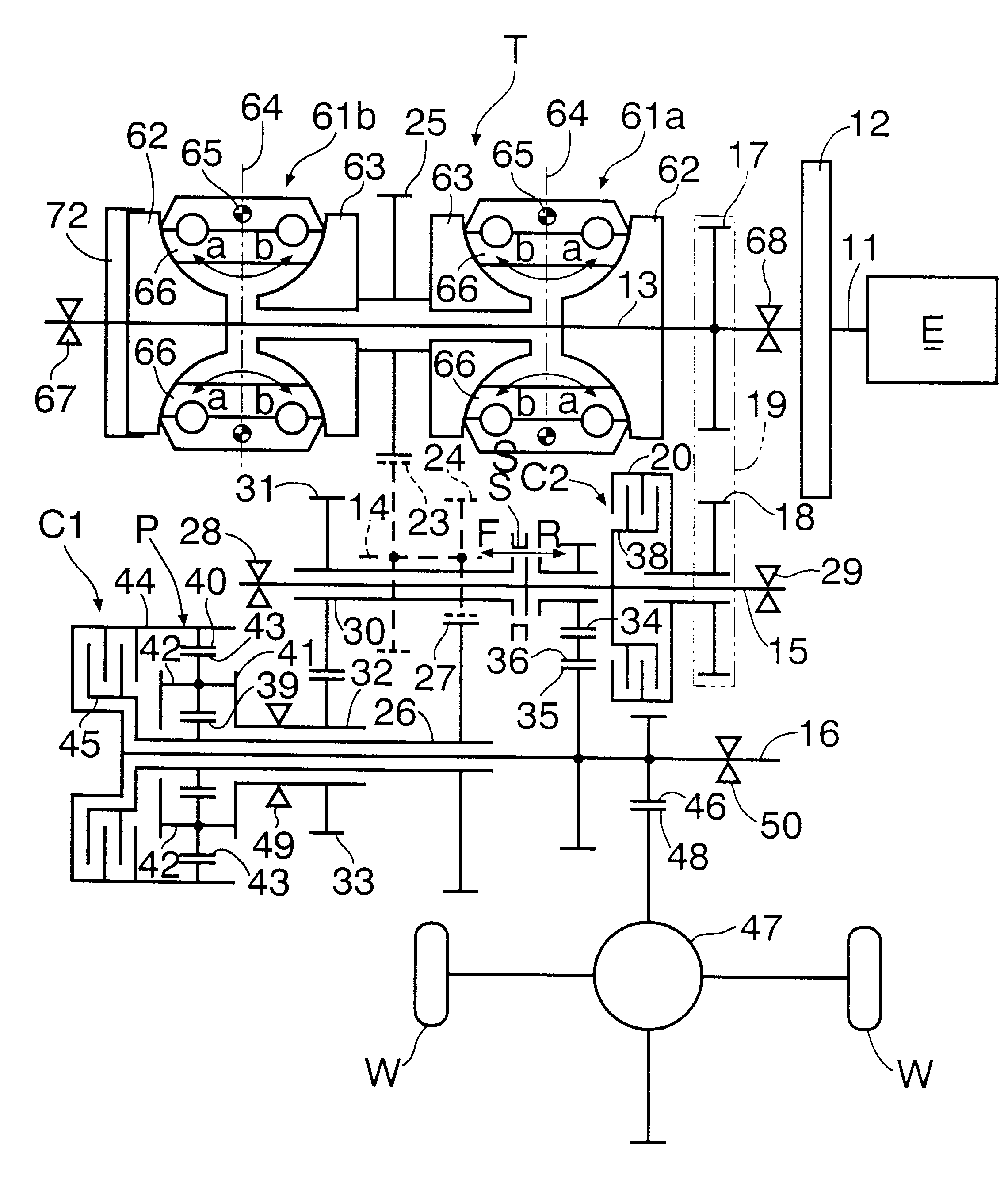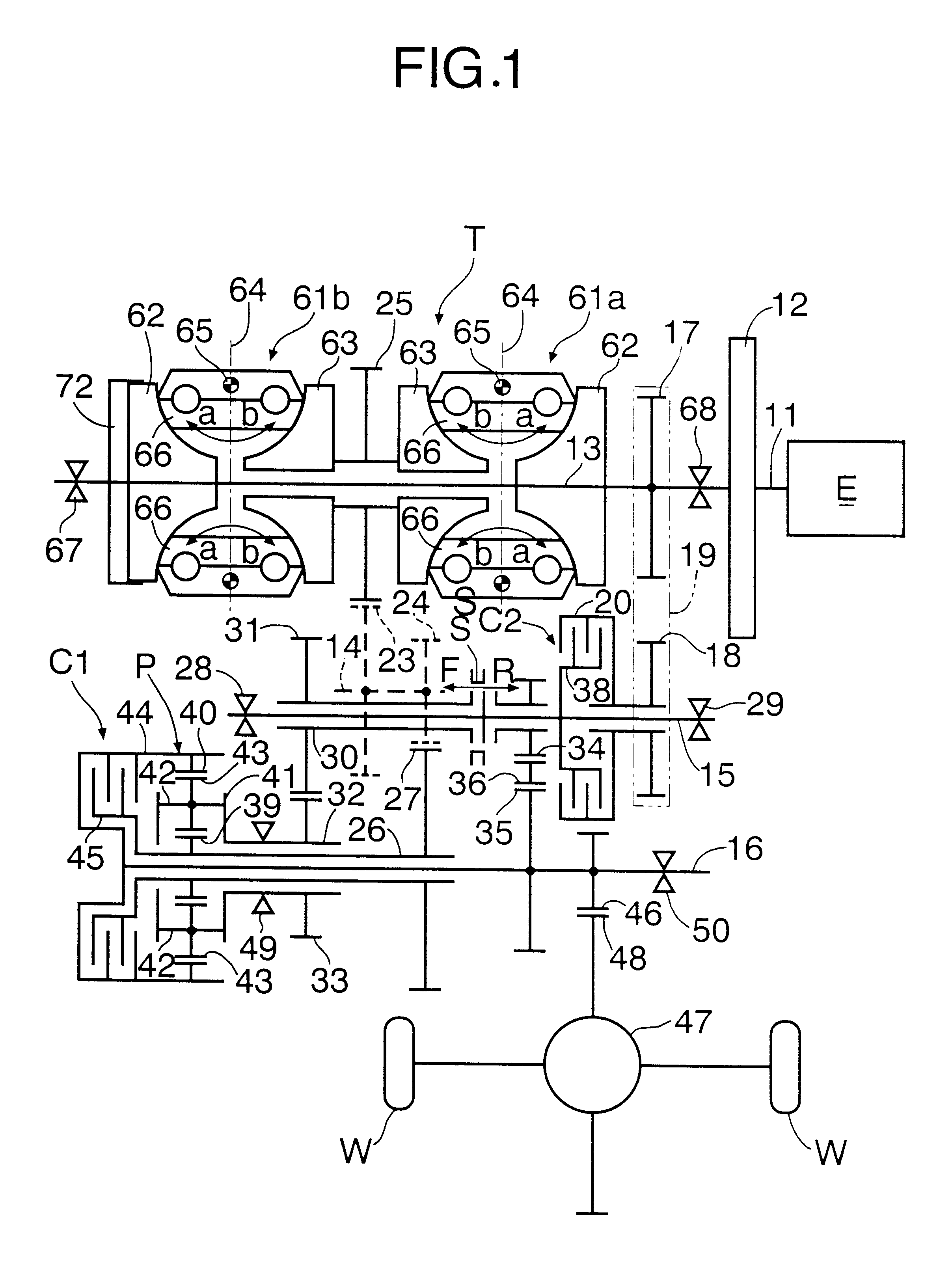Continuously variable transmission system for vehicle
a transmission system and continuously variable technology, applied in the direction of friction gearings, toothed gearings, gearings, etc., can solve the problems of affecting the transmission performance the inability to control the ratio of the toroidal type continuously variable transmission in some cases, and the deformation of the starting performan
- Summary
- Abstract
- Description
- Claims
- Application Information
AI Technical Summary
Benefits of technology
Problems solved by technology
Method used
Image
Examples
first embodiment
this invention is explained below with reference to FIGS. 1 to 13B.
As shown in FIG. 1 and FIGS. 3 to 5, a continuously variable transmission system for an automobile comprises a toroidal type continuously variable transmission T, a single pinion type planetary gear train P, a forward drive clutch C1, hereinafter called a first clutch C1, formed from a wet type multiplate clutch, and a reverse start and torque split clutch C2, hereinafter called a second clutch C2, formed from a wet type multiplate clutch. A crankshaft 11 of an engine E is connected to an input shaft 13 of the toroidal type continuously variable transmission T via a damper 12. A first shaft 14, a second shaft 15 and a third shaft 16 are placed parallel to the input shaft 13 of the toroidal type continuously variable transmission T. The first clutch C1 is provided on the left end of the third shaft 16, and the second clutch C2 is provided on the right end of the second shaft 15. A drive sprocket 17 fixed to the input ...
second embodiment
the present invention is now explained by reference to FIGS. 14 to 15B. The components of the present embodiment that corresponding to those in the first embodiment are denoted by the same reference symbols.
Although the planetary gear train P of the first embodiment shown in FIG. 1 is of a single pinion type, a planetary gear train P of the present embodiment is of a double pinion type. In the first embodiment, the output gear 25 of the toroidal type continuously variable transmission T is connected to the sun gear 39 of the planetary gear train P, whereas in the second embodiment, an output gear 25 of the toroidal type continuously variable transmission T, is connected to a carrier 41' of the planetary gear train P. Moreover, in the first embodiment, the driven wheels W are connected to the ring gear 40 of the planetary gear train P, whereas in the second embodiment, driven wheels W are connected to a sun gear 39' of the planetary gear train P. In the first embodiment, the second c...
third embodiment
the present invention is now explained with reference to FIG. 16.
The continuously variable transmission systems of the first and second embodiments are suitable for front engined front wheel drive vehicles in which the engine E is placed laterally. However, the continuously variable transmission system of the present embodiment is suitable for a front engined rear wheel drive vehicle in which the engine E is mounted longitudinally. The components of the present embodiment that correspond to those in the first and second embodiments are denoted using the same reference symbols.
A first shaft 131 and a second shaft 132 are placed coaxially with an input shaft 13 of a toroidal type continuously variable transmission T. The first shaft 131 rotates integrally with the input shaft 13, and the second shaft 132 is connected to driven wheels W (not illustrated). A third shaft 133 and a fourth shaft 134 are placed in parallel to the first shaft 131 and the second shaft 132. A first helical gea...
PUM
 Login to View More
Login to View More Abstract
Description
Claims
Application Information
 Login to View More
Login to View More - R&D
- Intellectual Property
- Life Sciences
- Materials
- Tech Scout
- Unparalleled Data Quality
- Higher Quality Content
- 60% Fewer Hallucinations
Browse by: Latest US Patents, China's latest patents, Technical Efficacy Thesaurus, Application Domain, Technology Topic, Popular Technical Reports.
© 2025 PatSnap. All rights reserved.Legal|Privacy policy|Modern Slavery Act Transparency Statement|Sitemap|About US| Contact US: help@patsnap.com



